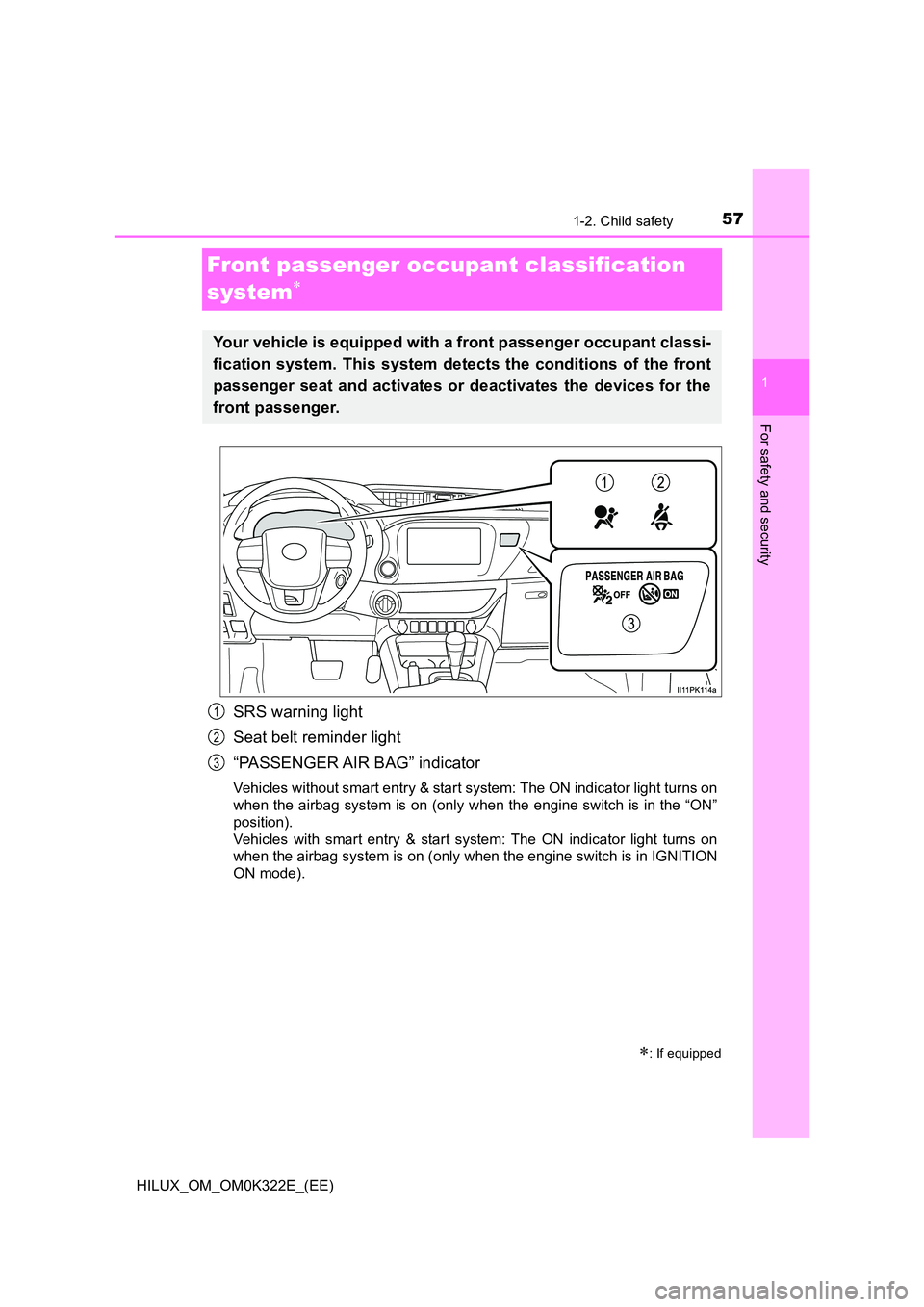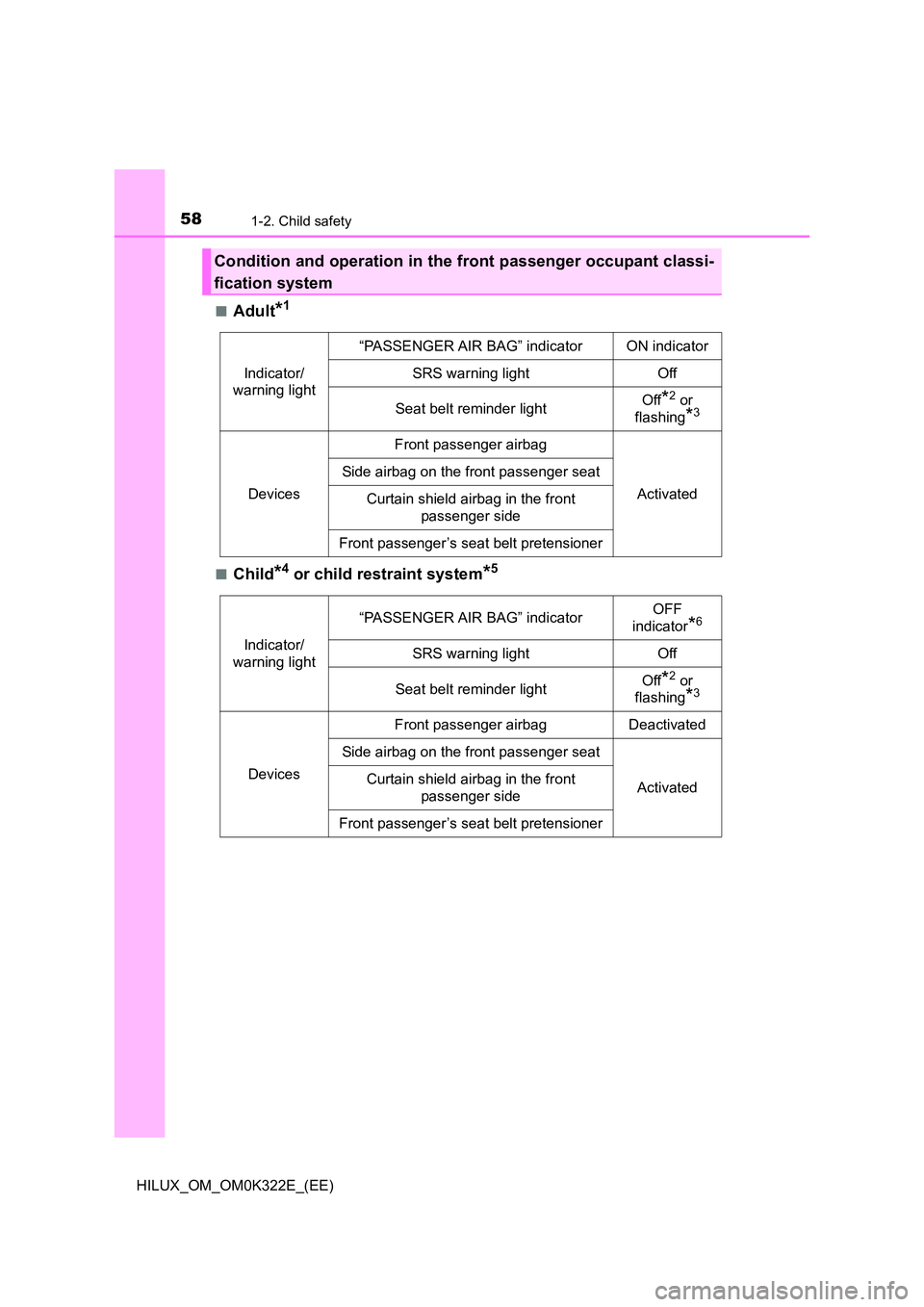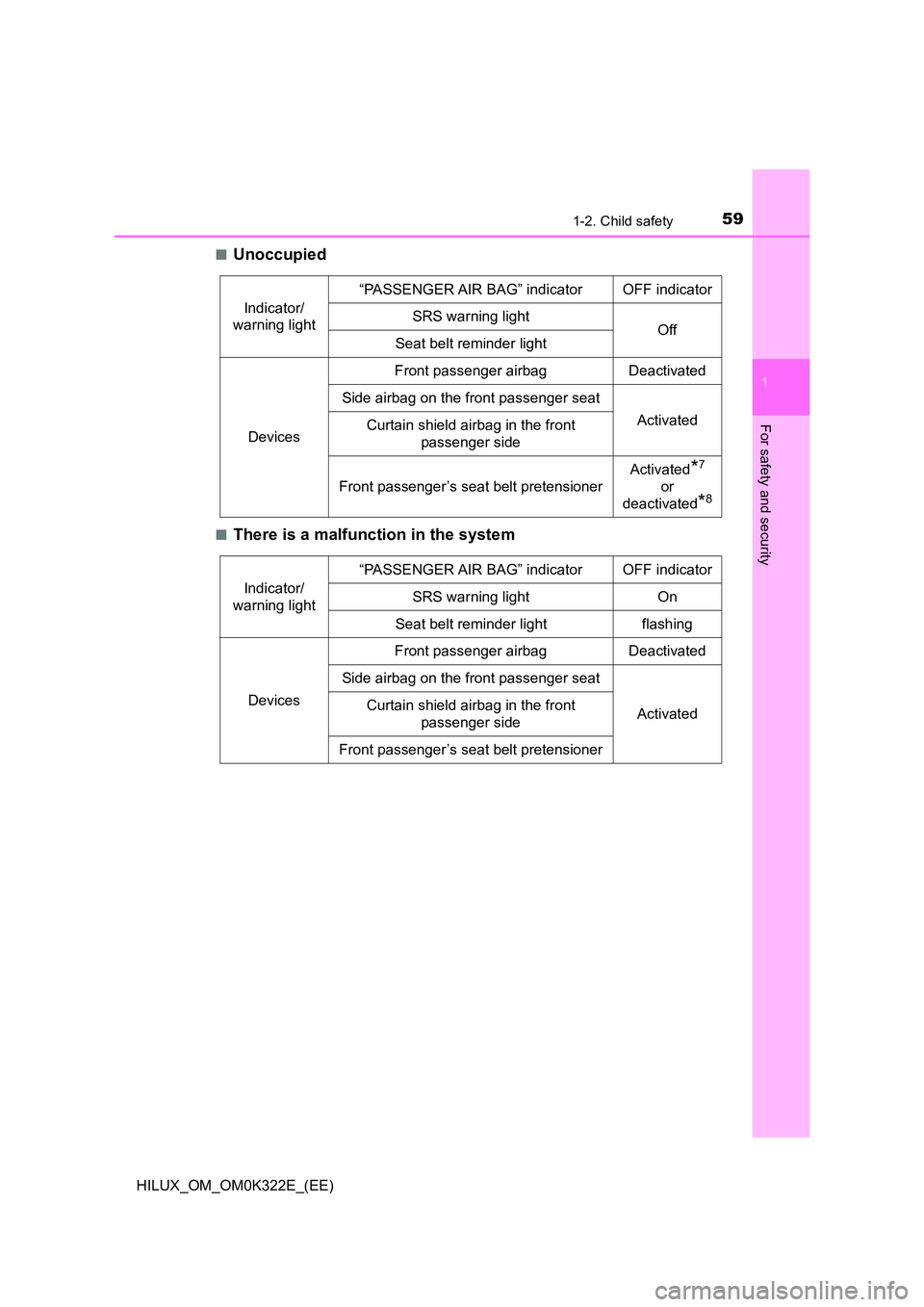2017 TOYOTA HILUX light
[x] Cancel search: lightPage 47 of 720

471-1. For safe use
1
HILUX_OM_OM0K322E_(EE)
For safety and security
The main SRS airbag system components are shown above. The
SRS airbag system is controlled by the airbag sensor assembly. As
the airbags deploy, a chemical reaction in the inflators quickly fills the
airbags with non-toxic gas to help restrain the motion of the occu-
pants.
WARNING
■ SRS airbag precautions
Observe the following precautions regarding the SRS airbags.
Failure to do so may cause death or serious injury.
● The driver and all passengers in the vehicle must wear their seat belts
properly.
The SRS airbags are supplemental devic es to be used with the seat belts.
● The SRS driver airbag deploys with considerable force, and can cause
death or serious injury especially if the driver is very close to the airbag.
Since the risk zone for the driver’s airbag is the first 50 - 75 mm (2 - 3 in.)
of inflation, placing yourself 250 mm ( 10 in.) from your driver airbag pro-
vides you with a clear margin of safety. This distance is measured from
the center of the steering wheel to your breastbone. If you sit less than
250 mm (10 in.) away now, you can change your driving position in sev-
eral ways:
• Move your seat to the rear as far as you can while still reaching the ped-
als comfortably.
• Slightly recline the back of the seat. Although vehicle designs vary,
many drivers can achieve the 250 mm (10 in.) distance, even with the
driver seat all the way forward, simply by reclining the back of the seat
somewhat. If reclining the back of your seat makes it hard to see the
road, raise yourself by using a firm, non-slippery cushion, or raise the
seat if your vehicle has that feature.
• If your steering wheel is adjustable, tilt it downward. This points the air-
bag toward your chest instead of your head and neck.
The seat should be adjusted as recommended above, while still maintain-
ing control of the foot pedals, steering wheel, and your view of the instru-
ment panel controls.
Page 52 of 720

521-1. For safe use
HILUX_OM_OM0K322E_(EE)
■If the SRS airbags deploy (inflate)
● Slight abrasions, burns, bruising etc., may be sustained from SRS airbags,
due to the extremely high speed deployment (inflation) by hot gases.
● A loud noise and white powder will be emitted.
● Vehicles without SRS curtain shield airbags: Parts of the airbag module
(steering wheel hub, airbag cover and inflator) as well as the front seats may
be hot for several minutes. The airbag itself may also be hot.
● Vehicles with SRS curtain shield airbags: Parts of the airbag module (steer-
ing wheel hub, airbag cover and inflator) as well as the front seats, parts of
the front and rear pillars, and roof side rails, may be hot for several minutes.
The airbag itself may also be hot.
● The windshield may crack.
● Vehicles with ERA-GLONASS/EVAK: If the SRS airbags deploy, the system
is designed to send an emergency call* to the ERA-GLONASS/EVAK con-
trol center, notifying them of the vehicle’s location (without needing to push
the “SOS” button) and an agent will attempt to speak with the occupants to
ascertain the level of emergency and assistance required. If the occupants
are unable to communicate, the agent automatically treats the call as an
emergency and helps to dispatch the necessary emergency services.
( P. 528)
*: In some cases, the call cannot be made. (P. 531)
■ SRS airbag deployment conditions (SRS front airbags)
● The SRS front airbags will deploy in the event of an impact that exceeds the
set threshold level (the level of force corresponding to an approximately 20 -
30 km/h [12 - 18 mph] frontal collision with a fixed wall that does not move or
deform).
However, this threshold velocity will be considerably higher in the following
situations:
• If the vehicle strikes an object, such as a parked vehicle or sign pole,
which can move or deform on impact
• If the vehicle is involved in an underride collision, such as a collision in
which the front of the vehicle “underrides”, or goes under, the bed of a
truck
● Depending on the type of collision, it is possible that only the seat belt pre-
tensioners will activate.
● Vehicles with front passenger occupant classification system: The SRS front
airbags for the front passenger will not activate if there is no passenger sit-
ting in the front passenger seat. However, the SRS front airbags for the front
passenger may deploy if luggage is put in the seat, even if the seat is unoc-
cupied.
Page 56 of 720

561-1. For safe use
HILUX_OM_OM0K322E_(EE)
Exhaust gas precautions
Harmful substance to the human body is included in exhaust
gases if inhaled.
WARNING
Exhaust gases include harmful carbon monoxide (CO), which is colorless and
odorless. Observe the following precautions.
Failure to do so may cause exhaust gases enter the vehicle and may lead to
an accident caused by light-headedness, or may lead to death or a serious
health hazard.
■ Important points while driving
If you smell exhaust gases in the vehicle, open the windows and have the
vehicle inspected at any authorized Toyota retailer or Toyota authorized
repairer, or any reliable repairer as soon as possible.
■ When parking
● If the vehicle is in a poorly ventilated area or a closed area, such as a
garage, stop the engine.
● Do not leave the vehicle with the engine running for a long time.
If such a situation cannot be avoided, park the vehicle in an open space
and ensure that exhaust fumes do not enter the vehicle interior.
● Do not leave the engine running in an area with snow build-up, or where it
is snowing. If snowbanks build up around the vehicle while the engine is
running, exhaust gases may collect and enter the vehicle.
■ Exhaust pipe
The exhaust system needs to be checked periodically. If there is a hole or
crack caused by corrosion, damage to a joint or abnormal exhaust noise, be
sure to have the vehicle inspected and repaired by any authorized Toyota
retailer or Toyota authorized repairer, or any reliable repairer.
Page 57 of 720

571-2. Child safety
1
HILUX_OM_OM0K322E_(EE)
For safety and security
Front passenger occupant classification
system
SRS warning light
Seat belt reminder light
“PASSENGER AIR BAG” indicator
Vehicles without smart entry & start system: The ON indicator light turns on
when the airbag system is on (only when the engine switch is in the “ON”
position).
Vehicles with smart entry & start system: The ON indicator light turns on
when the airbag system is on (only when the engine switch is in IGNITION
ON mode).
: If equipped
Your vehicle is equipped with a front passenger occupant classi-
fication system. This system detects the conditions of the front
passenger seat and activates or deactivates the devices for the
front passenger.
1
2
3
Page 58 of 720

581-2. Child safety
HILUX_OM_OM0K322E_(EE)
■Adult*1
■Child*4 or child restraint system*5
Condition and operation in the front passenger occupant classi-
fication system
Indicator/
warning light
“PASSENGER AIR BAG” indicator ON indicator
SRS warning light Off
Seat belt reminder light Off*2 or
flashing*3
Devices
Front passenger airbag
Activated
Side airbag on the front passenger seat
Curtain shield airbag in the front
passenger side
Front passenger’s seat belt pretensioner
Indicator/
warning light
“PASSENGER AIR BAG” indicator OFF
indicator*6
SRS warning light Off
Seat belt reminder light Off*2 or
flashing*3
Devices
Front passenger airbag Deactivated
Side airbag on the front passenger seat
Activated Curtain shield airbag in the front
passenger side
Front passenger’s seat belt pretensioner
Page 59 of 720

591-2. Child safety
1
HILUX_OM_OM0K322E_(EE)
For safety and security
■Unoccupied
■There is a malfunction in the system
Indicator/
warning light
“PASSENGER AIR BAG” indicator OFF indicator
SRS warning light OffSeat belt reminder light
Devices
Front passenger airbag Deactivated
Side airbag on the front passenger seat
Activated Curtain shield airbag in the front
passenger side
Front passenger’s seat belt pretensioner
Activated*7
or
deactivated*8
Indicator/
warning light
“PASSENGER AIR BAG” indicator OFF indicator
SRS warning light On
Seat belt reminder light flashing
Devices
Front passenger airbag Deactivated
Side airbag on the front passenger seat
Activated Curtain shield airbag in the front
passenger side
Front passenger’s seat belt pretensioner
Page 60 of 720

601-2. Child safety
HILUX_OM_OM0K322E_(EE)
*1: The system judges a person of adult size as an adult. When a smaller
adult sits in the front passenger seat, the system may recognize him/her
as a child depending on his/her physique and posture.
*2: In the event the front passenger is wearing a seat belt.
*3: In the event the front passenger does not wear a seat belt.
*4: When a larger child who has outgrown a child restraint system sits in the
front passenger seat, the system may recognize him/her as an adult
depending on his/her physique or posture.
*5: For the child’s safety, install the child restraint system to a rear seat.
When it is unavoidable, a child restraint system can be installed on the
front passenger seat. A rear-facing child restraint system should be
installed when “OFF” of the “PASSENGER AIR BAG” indicator is illumi-
nated. ( P. 6 5 )
*6: In case the indicator light is not illuminated, consult this manual on how to
install the child restraint system properly. ( P. 65)
*7: In the event of a side collision.
*8: In the event of a frontal collision.
WARNING
■Front passenger occupant classification system precautions
Observe the following precautions regarding the front passenger occupant
classification system.
Failure to do so may cause death or serious injury.
● Wear the seat belt properly.
● Make sure the front passenger’s seat belt plate has not been left inserted
into the buckle before someone sits in the front passenger seat.
● Do not apply a heavy load to the front passenger seat or equipment (e.g.
seatback pocket or armrest).
● Do not put weight on the front passenger seat by putting your hands or
feet on the front passenger seat seatback from the rear passenger seat.
● Do not let a rear passenger lift the front passenger seat with their feet or
press on the seatback with their legs.
● Do not put objects under the front passenger seat.
Page 61 of 720

611-2. Child safety
1
HILUX_OM_OM0K322E_(EE)
For safety and security
WARNING
■Front passenger occupant classification system precautions
● Do not recline the front passenger seatback so far that it touches a rear
seat. This may cause “OFF” of the “PASSENGER AIR BAG” indicator to
be illuminated, which indicates that the SRS airbags for the front passen-
ger will not activate in the event of a severe accident. If the seatback
touches the rear seat, return the seatback to a position where it does not
touch the rear seat. Keep the front passenger seatback as upright as pos-
sible when the vehicle is moving. Reclining the seatback excessively may
lessen the effectiveness of the seat belt system.
● If an adult sits in the front passenger seat, “ON” of the “PASSENGER AIR
BAG” indicator is illuminated. If “OFF ” of the “PASSENGER AIR BAG” indi-
cator is illuminated, ask the passenger to sit up straight, well back in the
seat, feet on the floor, and with the seat belt worn correctly. If “OFF” of the
“PASSENGER AIR BAG” indicator still re mains illuminated, either ask the
passenger to move to the rear seat, or if that is not possible, move the
front passenger seat fully rearward.
● When it is unavoidable to install a child restraint system on the front pas-
senger seat, install the child restraint system on the front passenger seat
in the proper order. ( P. 65)
● Do not modify or remove the front seats.
● Do not kick the front passenger seat or subject it to severe impact. Other-
wise, the SRS warning light may come on to indicate a malfunction of the
front passenger occupant classification system. In this case, contact any
authorized Toyota retailer or Toyota authorized repairer, or any reliable
repairer immediately.
● Child restraint systems installed on the rear seat should not contact the
front seatbacks.
● Do not use a seat accessory, such as a cushion and seat cover, that cov-
ers the seat cushion surface.
● Do not modify or replace the upholstery of the front seat.
● When it is unavoidable to install a rear-facing child restraint system on the
front passenger seat, do not release the seat belt while the vehicle is mov-
ing. Doing so may cause the airbag system to be on.